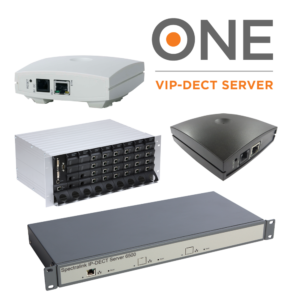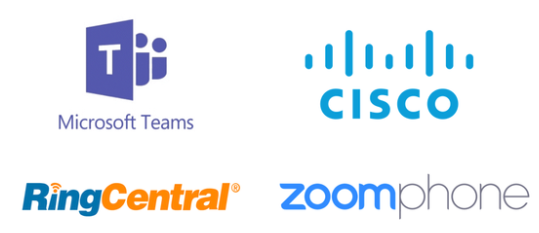
Spectralink DECT servers enable seamless performance and reliable coverage, so deskless workers can confidently roam without losing connectivity across large or complex sites. As your business grows, the flexible and scalable design of Spectralink DECT servers allows the solution to adapt to your changing needs. Our powerful servers integrate with industry-leading applications for alarms, alerts, and key workflows.
 Product highlights:
Product highlights:
- Seamless multi-cell roaming across large sites and even different locations
- Interoperable with leading Call Control / Unified Communications platforms like MS Teams, RingCentral, and Zoom
- Integrates with applications and messaging, and alarm platforms
- Certified to the highest level of DECT security
- Supports migration from legacy PBX to new hybrid VoIP and UCaaS cloud-based infrastructures
- Easily and centrally managed with AMIE Advanced for IP-DECT
Virtual IP-DECT Server
VIP-DECT Server One
VIP-DECT Server One is the first of its kind on the market, a software-only platform that offers instant scalability to flexibly connect large enterprises with central and distributed sites. Quickly deploy and expand DECT mobility networks without installing additional hardware.
Contact Us Download SpecsFeatures:
- Supports 16,000 users and 4,096 IP-DECT Base Stations
- The first software-only IP-DECT architecture to enable connections over WAN or Internet
- Provides branch survivability if connection with host UC/UCaaS platform is lost
- Single centralized web portal for administration and maintenance

IP-DECT Server
Spectralink IP-DECT Server 6500
Designed for medium to large organizations, the Spectralink IP-DECT Server 6500 provides coverage across vast sites with many deskless workers. The flexible and scalable elements of IP-DECT Server 6500 can be customized to meet business needs now and as needs expand, making it a future-proof solution for fast-growing businesses.
Contact Us Download SpecsFeatures:
- Supports 4,096 users and 1,024 base stations
- Modular design allows the solution to be assembled to match the needs of your business today and to support any future growth demand
- Easily increase the number of voice channels and/or geographical radio coverage
- Flexible license options so businesses only pay for the features and capacity they need now and can upgrade with growth

IP-DECT Server
Spectralink IP-DECT Server 400
The Spectralink IP-DECT Server 400 can be deployed as a single or multi-cell solution. This scalability ensures that the IP-DECT Server 400 solution can grow with your business to fit your exact needs, making it a future-proof solution for small to medium-sized businesses.
Contact Us Download SpecsFeatures:
- Can be deployed as a single-cell or a multi-cell solution
- Supports 12 users, 12 simultaneous calls and 19 base stations
- With optional expansion license, supports 60 users, 24 simultaneous calls
- Acts as both a radio and SIP integration unit to integrate with host SIP IP-PBX (On-prem or UCaaS)

DECT Server
Spectralink DECT Server 8000
The Spectralink Hybrid DECT Server 8000 is designed for fast-growing medium to large organizations. The modular, scalable, and flexible server supports analog and SIP interface for the host call control platform. With its modular architecture and ability to scale easily, it fits the needs of businesses today and in the future.
Contact Us Download SpecsFeatures:
- Supports up to 4,095 users with VoIP interface and up to 1,024 simultaneous calls
- Combines digital and SIP VoIP interfaces, allowing customers to use the two interfaces simultaneously
- Room for 1 CPU card and up to 8 interface cards. Up to 8 servers can be linked for a total of 64 slots, allowing for numerous ways of combining base station cards, analog interface card, and VoIP interface card to assemble a customized solution
- Upgradeable to an IP-DECT Gateway controlled and managed from any Spectralink multi-cell IP-DECT Server

DECT Infrastructure
IP-DECT Base Station
Over the air call signaling between your DECT server and handsets
Contact Us Download SpecsFeatures:
- Provides the link between handsets and servers
- Supports up to 12 simultaneous traffic channels (32 Kbit/s)
- Typical radio coverage distance: up to 50m indoors, 300m open space (150 to 1000 feet)
- No external power required — powered from the PoE enabled LAN network
- Connect a Spectralink DECT Repeater and/ or a Spectralink DECT External Antenna to extend the coverage
- Fast and easy installation
- Interoperates with all Spectralink DECT Servers

DECT Infrastructure
DECT Base Station
Over the air signaling between the Spectralink DECT Server 8000
Contact Us Download SpecsFeatures:
- 4/8 simultaneous traffic channels (32 Kbit/s)
- Option to mount External Antennas to extend coverage where needed
- Frame synchronization via the Spectralink DECT Server
- Fast and easy installation — two wired twisted pair of cables connection to the Spectralink DECT Server
- No external power required — powered from the Spectralink DECT Server directly
- Typical radio coverage distance: up to 50m indoors, 300m open space (150 to 1000 feet)

DECT Infrastructure
DECT Repeater
Extend Wireless Telephony Coverage Area
Contact Us Download SpecsFeatures:
- Wireless – no cabling needed
- Create coverage in a remote area
- Expand coverage in a single cell solution
- Increase coverage in hot spot areas
- 2 or 4 speech channels

Contact Us
Why Spectralink DECT
Spectralink DECT emerges as the premier solution with its unparalleled benefits. The AMIE feature ensures smooth operations, preventing downtime. It boasts unmatched integration with top UCaaS platforms, offering robust support for workers in any location. The system is dependable in harsh work environments, scalable to accommodate growing business needs, and adaptable to legacy DECT cabling. With crystal-clear voice quality and Step B DECT security, it safeguards data and calls effectively.
